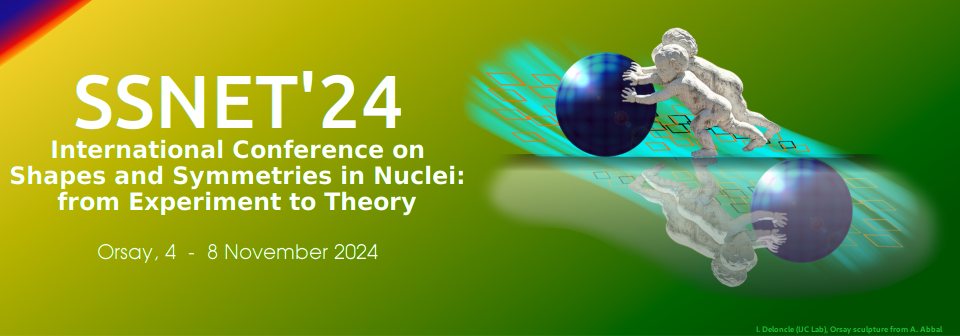Investigating the properties of individual nucleons leads to a more detailed exploration of
nuclear physics. We employ the relativistic mean-field model to study the behavior of nuclei and nuclear matter. Nuclear density is treated as a fundamental variable, and an energy function is employed to depict the interactions between the nucleons. The conventional Hartree-Fock Bogoliubov model is...
This study examines the use of a sextic oscillator in the 𝛽 degree of freedom of the Bohr Hamiltonian to understand critical point solutions in nuclear transitions from spherical to deformed forms. We begin by examining critical point solutions such as E(5), which model the 𝛽 degree of freedom using an infinite square-well (ISW) potential. This model is essential for examining phase...
Shape of nuclei is determined by a fine balance between the stabilizing effect of closed shells and the pairing and quadrupole forces that tend to induce deformation [1]. In the mass region around A=100, there exist clear cut examples of the rapid appearance of deformation such as Zr (even-even) [2] and Nb isotopes (odd-even) [3], which can be understood in terms of the coexistence of two...
The stability of nuclei has traditionally found explanation through the concept of magic numbers, comprehensively elucidated by the interplay of central and spin-orbit interactions. However, as we venture into the domain of unstable nuclei, these foundational ingredients begin to exhibit limitations. Roughly two decades ago, the tensor interaction was introduced as an attempt to address these...
Abstract: Understanding the structural transition of nuclei at fission limits is a fascinating and ongoing investigation in nuclear physics. The Giant Dipole Resonance (GDR) is a significant probe for investigating the shape evolution of an atomic nucleus [1]. However, it is challenging to differentiate GDR γ-ray emissions before and after the fission reaction, as validated by existing...
In the study of thermal neutron-induced fission of \textsuperscript{235}U, a dispersion in the experimental data concerning the average prompt neutron multiplicity $\overline{\nu}$ as a function of the pre-neutron mass $A$ of the fragments was observed [1]. To identify the source of this dispersion, we have conducted a Monte Carlo simulation of the measurement process carried out with the 2E...
Pairing in atomic nuclei reveals profound insights into the intrinsic behavior and properties of nuclear systems [1]. Numerous theories have arisen in the exploration of this field, with particular significance attributed to the BCS theory [2]. Extending the boundaries of this theory, the Finite Temperature BCS (FTBCS) theory, with the inclusion of angular momentum [3], has emerged as an...
Abstract:
The potential energy surface of 182-186Pt, 184-188Hg, and 186-190Pb in the 4D deformation parameters space (c,ŋ,a3,a4) are evaluated within the macroscopic-microscopic approach using the so-called Fourier-over-Spheroid shape parametrization [1]. The LSD formula [2] is used to evaluate the macroscopic part of the energy, while the microscopic energy correction was obtained using...
The Gogny-type density functionals have finite-range and density-dependent terms. The parameters of the functionals are designed not only to reproduce the basic properties of finite nuclei but also to satisfy the saturation properties of nuclear matter. Consequently, calculations using a single density functionals can describe experimental data in various mass regions. However, the mean-field...
Tellurium isotopes in the A $\approx$ 125 mass region are good candidates to study shape changes owing to their transitional nature. The h$_{11/2}$ intruder orbitals in this region drives the nuclear shape. The protons occupying the low-$\Omega$ h$_{11/2}$ orbitals drive the nucleus to a prolate shape while the neutrons in the mid to high $\Omega$ orbitals result in an oblate shape....
The valence nucleons are subject to Coriolis and centrifugal forces caused by the rotation of the core of the nucleus. These forces lead to an energy shift between the states with even and odd spins within a rotational band based on the total angular momentum of the states, resulting in the formation of two bands with a ΔI = 2 connection through M1/E2 transitions. Each band is characterized by...
Double alpha decay, a simultaneous emission of two alpha particles by the nucleus, is a possible rare decay mode first discussed in 1979 [1]. This decay was considered as two competing processes: immediate two particle emission or the emission of a 8Be-cluster with its instantaneous disintegration. However, the predicted half-lives for trans-lead isotopes were found to be too long for simple...
The β-delayed γ-ray spectroscopy of neutron-rich Ru isotopes is investigated at the Radioactive Isotope Beam Factory of RIKEN. The β-decay schemes of these nuclei are established with the use of prompt-prompt and prompt-delayed γ-γ-coincidence measurement by EURICA γ-ray detection array [1]. The systematic trends of low-lying states and their implications on single-particle orbit and shape...
We have studied the formation of new nuclei in high-energy heavy-ion collisions, using the intranuclear cascade interaction hypothesis. In this study, ultra-relativistic interaction dynamics, the Dubna cascade model (DCM) and the statistical multifragmentation model are applied to theoretical calculations of hypernuclear production. Good agreement with experimental data is achieved within our...

